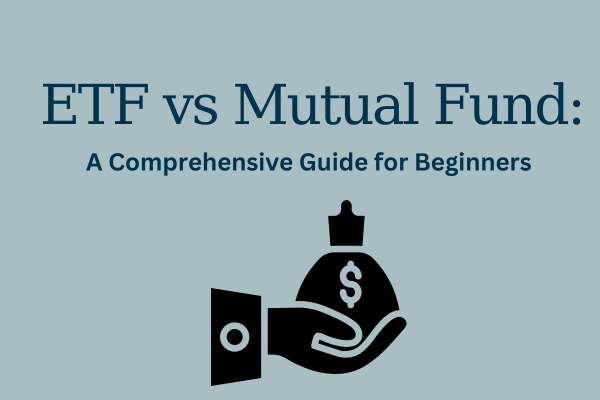Let’s face it, investing can feel like decoding a secret language. Terms like ETFs, NAV, and SIPs get thrown around, leaving many beginners wondering, “Where do I even start?” If you’re an Indian investor staring at your savings account and dreaming of better returns, you’re not alone. With mutual funds managing over ₹53 lakh crore in assets (AMFI, 2024) and ETFs gaining traction on platforms like Zerodha and Groww, the choices are overwhelming. But don’t sweat it—this guide breaks down ETF vs mutual fund in plain English, tailored for India’s unique market.
Table of Contents
What Are ETFs and Mutual Funds? (And Why Should You Care?)
Mutual Funds: The Classic Choice
Mutual funds pool money from thousands of investors to buy stocks, bonds, or other assets. They’re managed by pros who pick investments, making them a “set-and-forget” option. Popular in India for decades, they’re like the dal chawal of investing—reliable and familiar.
Example: The SBI Bluechip Fund, which invests in top Indian companies like Reliance and HDFC Bank, has delivered ~15% annual returns over five years (Value Research).
ETFs: The New Kid on the Block
Exchange-Traded Funds (ETFs) are baskets of securities traded on stock exchanges, like individual stocks. They usually track indices (e.g., Nifty 50) and have lower fees. Think of them as ready-to-eat upma—quick, affordable, and transparent.
Example: The Nippon India ETF Nifty 50 BeES lets you own the top 50 Indian companies with an expense ratio of just 0.05%!
Key Differences: ETFs vs Mutual Funds
Here’s where things get spicy. Let’s compare these two side-by-side:

| Feature | Mutual Funds | ETFs |
|---|---|---|
| Pricing | NAV calculated once daily | Real-time prices (like stocks) |
| Costs | Higher expense ratios (1-2%) | Lower fees (0.05-0.5%) |
| Liquidity | Redeemable anytime (T+2 days) | Traded instantly during hours |
| Minimum Investment | ₹500-₹1,000 via SIP | 1 unit (e.g., ₹150 for Nifty ETF) |
Fun fact: Did you know ETFs were introduced in India in 2001? Yet, mutual funds still dominate because of SIP culture.
Pros and Cons: Which Suits Your Wallet?
Mutual Funds: The Good and the Bad
Pros:
- SIP options (start with ₹500/month).
- Actively managed—pros handle stock picks.
- Great for long-term goals (child’s education, retirement).
Cons:
- Higher fees eat into returns over time.
- Less transparent (you won’t know daily holdings).
ETFs: The Upsides and Downsides
Pros:
- Lower costs = more money stays invested.
- Trade anytime, ideal for tactical investors.
- Transparent (holdings published daily).
Cons:
- Requires brokerage account and trading knowledge.
- No SIP option (though you can manually invest monthly).
Personal anecdote: My friend Riya started with mutual funds but switched to ETFs after realizing she was paying ₹20,000/year in fees!
Real-World Examples in India (2024 Edition)
- Case Study 1:
- Mutual Fund: Axis Long-Term Equity Fund (ELSS) helped Aarav save ₹1.5 lakh in taxes while earning 12% CAGR.
- ETF: Mirae Asset NYSE FANG+ ETF gave Priya exposure to global tech giants like Apple and Tesla.
- Recent Trend:
Gold ETFs surged 18% in 2023 as Indians hedged against inflation (NSE data). - Stat Alert:
ETF assets in India crossed ₹5 lakh crore in 2024, up 40% from 2022 (CRISIL).
How to Choose: A Step-by-Step Guide for Beginners
- Ask Yourself:
- “Do I want hands-off investing?” → Mutual funds.
- “Am I okay with trading?” → ETFs.
- Check Costs:
Compare expense ratios on Coin by Zerodha or AMFI’s website. - Test the Waters:
Start a ₹500 SIP in a flexi-cap fund and buy 1 unit of a Nifty ETF. See which feels right. - Avoid FOMO:
Don’t chase “hot” funds. Consistency beats hype.
The Contrarian Take: SIPs Aren’t Always King
Conventional wisdom says SIPs in mutual funds are unbeatable. But here’s a twist: ETFs can outperform SIPs if you invest lumpsum during market dips. For example, investing ₹50,000 in a Nifty ETF during the 2020 crash would’ve doubled your money by 2023. Of course, timing the market is risky—but it’s a reminder that ETFs offer flexibility SIPs can’t.
Wrapping Up: Your Money, Your Rules
Whether you pick ETFs or mutual funds, the goal is the same: growing wealth. For beginners, mutual funds offer simplicity, while ETFs reward hands-on learners. And hey, you can always mix both!

